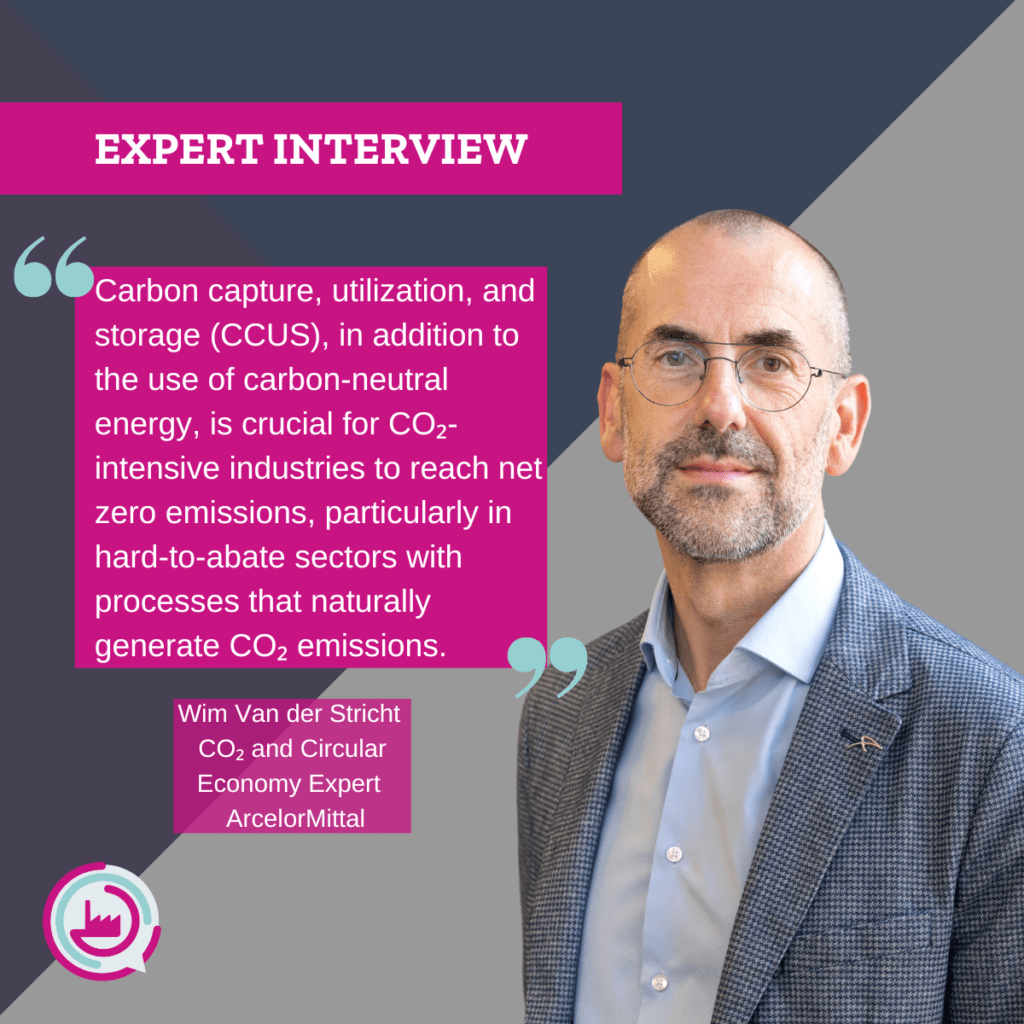Wim Van der Stricht has participated in the RE4Industry project describing two projects developed at ArcelorMittal plant in Ghent, Belgium. These projects are an excellent example of the climate action initiatives to facilitate the energy-intensive industry (EII) sector in Europe and a smooth and more secure transition to the adoption of Renewable Energies (RE).
Wim holds a PhD by Ghent University in Engineering. He is Responsible for the Technology Strategy – CO2 and circular economy at ArcelorMittal where he has spent the last 23 years. RE4Industry interviewed him on the steps ArcelorMittal is taking to achieve its decarbonisation goals.
What actions is ArcelorMittal currently developing or planning to achieve its decarbonisation goals?
The company has set a target to reduce fossil carbon emissions by 3.9 million tonnes per year by 2030. A 2.5 million-tonnes direct reduced iron (DRI) plant and electric arc furnace (EAF) facility at its Ghent site will operate alongside Ghent’s state-of-the-art partially waste wood and plastic fired blast furnace (Horizon2020 Torero project en Life+ Smart-Life project). Carbalyst/Steelanol project promotes CCU by converting biological waste gases captured from blast furnaces into (bio)ethanol. This ethanol can be re-used as a chemical feedstock or blended for use as a liquid fuel. Additionally, 15 wind turbines have been installed promoting the use of wind energy. Moreover, the installation of more than 27.000 solar panels on the roof of ArcelorMittal warehouses in the Ghent plant has been completed, being the largest solar roof in Belgium. Currently, ArcelorMittal owns the fourth-largest solar park in Belgium and the largest solar roof in Belgium. Finally, ArcelorMittal Belgium and Dow Benelux have carried out trials with a new pilot plant on ArcelorMittal’s premises in Gent that separates carbon dioxide (CO2) and carbon monoxide (CO) from the hot flue gases produced during steel production (Carbon2Value Interreg2Seas and Steel2Chemicals VLAIO project). In total, this will lead to a CO2 emissions reduction of 3 million tonnes a year, compared with 2018, and enables the creation of synergies in ArcelorMittal Belgium’s roadmap to reaching net zero carbon emissions by 2050.
Besides the reduction of overall emissions by the company, what has been the impact of these climate action measures on social and marketing aspects?
ArcelorMittal Belgium as well as its operations in Germany, Spain, France, and Luxembourg sites received ResponsibleSteel certification in 2022. A non-profit organization called ResponsibleSteel™ is developing sustainability performance standards and a steel value chain third-party certification scheme. The ResponsibleSteel™ certification provides the customers and consumers the confidence that carbon reduction goals, as well as expectations on environmental and social standards, are satisfied at every stage of production.
What are ArcelorMittal’s future steps and future collaborations?
Carbon capture, utilization, and storage (CCUS), in addition to the use of carbon-neutral energy, is crucial for CO2-intensive industries to reach net zero emissions, particularly in hard-to-abate sectors with processes that naturally generate CO2 emissions. To overcome this, ArcelorMittal with Fluxus and North Sea Port has started preparing a feasibility study for the Ghent Carbon Hub project, an open-access CO2 storage and liquefaction hub in the Ghent part of North Sea Port. The Ghent Carbon Hub will be operational in 2027 and have the capacity to process 6 million tonnes of CO2 annually (MTPA), equivalent to around 15% of industrial CO2 emissions in Belgium. Additionally, ArcelorMittal Belgium is starting a new initiative called SMART-LIFE: Steelmaking with Alternative Reductants” in Collaboration with Vanheede Environment Group, Ghent University, and CRM group. This project is a cutting-edge process to chemically recover end-of-life plastics and other waste in order to reduce CO2 emissions. With the help of the SMART project, ArcelorMittal can replace fossil carbon-containing reductants, such as coal, with circular waste-based reductants. Furthermore, a pilot project to employ bio-coal as a high-quality partial replacement for fossil coal is being launched by ArcelorMittal Ghent. The bio-coal will be partially produced on-site with the Torero project from waste wood and responsibly sourced via bio-pellets from a third-party producer. The biocoal production will start with 37,500 tonnes to inject in the blast furnace, with an ambition to increase to 350,000 tonnes of bio-coal annually. Finally, leading global resources company BHP, Mitsubishi Heavy Industries Engineering (MHIENG), and Mitsubishi Development Pty Ltd are working together on a multi-year experiment of MHIENG’s carbon capture technology with ArcelorMittal. To assist the move toward full-scale implementation, the companies will also carry out a feasibility and design study. The agreement involves a pilot at the ArcelorMittal Ghent site and at another location in North America. The study in Ghent will include two parts. Due to the varying quantities of pollutants in the top gas, the first step entails isolating and extracting the CO2 top gas from the blast furnace at a rate of around 300 kg per day. The hot strip mill-reheating furnace, which burns a variety of industrial gases comprising coke gas, blast furnace gases, and natural gas, is used in the second phase to evaluate the separation and capture of CO2 from the off-gases.
